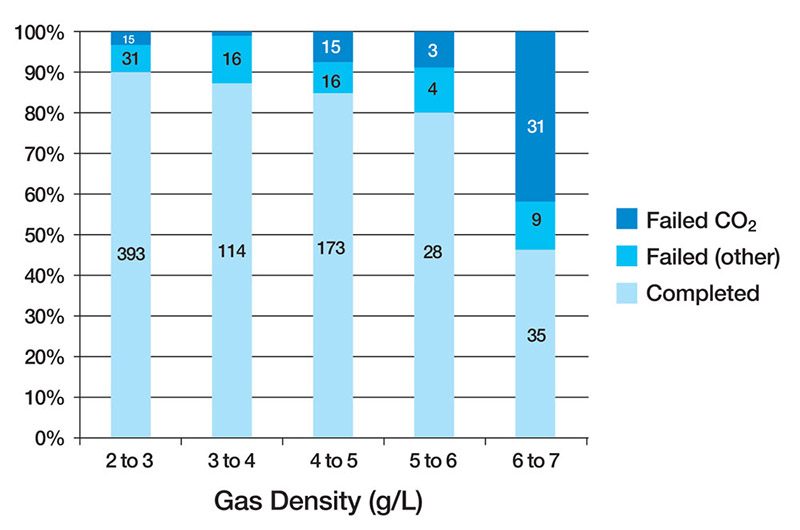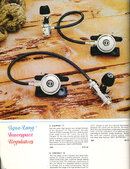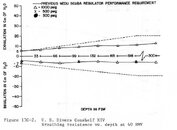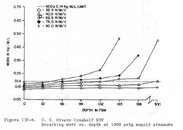Hi, not to be nitpicky, I just finished my TDI AN/DP courses and it is to 45metres with just air and in my case was 50% Nitrox. No helium. This is as per agency directions.Below 40m WITHOUT HELIUM, I consider reckless.
You are using an out of date browser. It may not display this or other websites correctly.
You should upgrade or use an alternative browser.
You should upgrade or use an alternative browser.
Question When do we speak of technical diving ?
- Thread starter Klopo
- Start date
Please register or login
Welcome to ScubaBoard, the world's largest scuba diving community. Registration is not required to read the forums, but we encourage you to join. Joining has its benefits and enables you to participate in the discussions.
Benefits of registering include
- Ability to post and comment on topics and discussions.
- A Free photo gallery to share your dive photos with the world.
- You can make this box go away
@helgo,Hi, not to be nitpicky, I just finished my TDI AN/DP courses and it is to 45metres with just air and in my case was 50% Nitrox. No helium. This is as per agency directions.
Regardless what you were taught in your recent TDI AN/DP course, some (many?) divers will safely dive air deeper than 45 meters (150 ft)--sometimes because He is not available, other times simply because they can and have done so "forever."
One of my most amazing dives was a 165 fsw air dive on a deep reef off Grand Cayman in 2000--my first and only "technical dive" that didn't involve a drysuit with thick hood and thick gloves and BM, manifolded HP100/120's and freezing my face off during deco stops in Lake Superior.
I suppose I could have waited until I had become Tri-Mix certified to do this GCI dive. But, no. Especially since I had already done many much deeper air dives, on Great Lakes shipwrecks, at that time.
rx7diver
Yes, I am a very newly certified technical diver, so I don't claim to know much. All of my tech dives have been in 26 celsius water with 3mil!@helgo,
Regardless what you were taught in your recent TDI AN/DP course, some (many?) divers will safely dive air deeper than 45 meters (150 ft)--sometimes because He is not available, other times simply because they can and have done so "forever."
One of my most amazing dives was a 165 fsw air dive on a deep reef off Grand Cayman in 2000--my first and only "technical dive" that didn't involve a drysuit with thick hood and thick gloves and BM, manifolded HP100/120's and freezing my face off during deco stops in Lake Superior.
I suppose I could have waited until I had become Tri-Mix certified to do this GCI dive. But, no. Especially since I had already done many much deeper air dives, on Great Lakes shipwrecks, at that time.
rx7diver
Anyhow, it just seemed to be such a strong statement to say anything below 40meteres without Helium is reckless, especially when I did exactly this multiple times in the TDI course!
Hi, I'm signed up for TDI ANDP course, so can you clarify that at 45 meters you had air AND 50% Nitrox? I've seen many comments that regular air at 40 meters or deeper runs risks. Can you opt to have another gas in lieu of air? Also, how did you like/dislike the course? Just asking as I'm taking mine in April/May.Hi, not to be nitpicky, I just finished my TDI AN/DP courses and it is to 45metres with just air and in my case was 50% Nitrox. No helium. This is as per agency directions.
Hello, I can speak only to my experience and recent knowledge of TDI AN/DP course.Hi, I'm signed up for TDI ANDP course, so can you clarify that at 45 meters you had air AND 50% Nitrox? I've seen many comments that regular air at 40 meters or deeper runs risks. Can you opt to have another gas in lieu of air? Also, how did you like/dislike the course? Just asking as I'm taking mine in April/May.
Regular air / 21% oxygen has an MOD of 187 with PPO2 of 1.4.
Nitrogen narcosis being your biggest risk - in my case we did progressively deeper dives, like 80,,100,130 and then 150 feet so that my instructor could see how I do and how I am affected by the nitrogen narcosis.
150 feet is 5.5 ATA, you could theoretically do 25% nitrox, which has MOD of 150feet, but I have a feeling not many ppl do this. Others can weigh in on this maybe.
So the 50% Nitrox was carried as a stage tank on my left. 50% Nitrox has a MOD of 70 feet with 1.4 , so we switched to the 50% at 70 feet, because that significantly lessens your Deco time after spending 20mins at 150 feet.
The course was good and very comprehensive.
There are many things to learn about the different gear configuration.
I did buy Oxycheq 55wing, and Perdix 2 along with Teric. Holding off buying doubles regs for now. From what I could see, a swivel turret and 5th / downward facing port on the 1st stage is REALLY nice to have and greatly improves your hose routing. So when I saw that , I no longer feel the Apeks Tek 3 is my 1st choice, more the Apeks DST with swivel and 5th port,
I recommend do the TDI courses online and start with DP first and then AN, the latter has much more serious math!!
Keep in mind that in addition to PPO2, gas density and CO2 will also greatly influence your safety on deeper dives. Have a look at Simon Mitchels table of divererrors related to gas density in rebreatherdivers. While this table is specific to reabreathers, the consept of higher WOB is still valid also for OC divers. Higher density gas gives higher work of breath, and increased levels of CO2 with very little work introduced. CO2 is highly narcotic and in cohort with nitrogen will severely compromise cognitive functions.Hello, I can speak only to my experience and recent knowledge of TDI AN/DP course.
Regular air / 21% oxygen has an MOD of 187 with PPO2 of 1.4.
Nitrogen narcosis being your biggest risk - in my case we did progressively deeper dives, like 80,,100,130 and then 150 feet so that my instructor could see how I do and how I am affected by the nitrogen narcosis.
150 feet is 5.5 ATA, you could theoretically do 25% nitrox, which has MOD of 150feet, but I have a feeling not many ppl do this. Others can weigh in on this maybe.
So the 50% Nitrox was carried as a stage tank on my left. 50% Nitrox has a MOD of 70 feet with 1.4 , so we switched to the 50% at 70 feet, because that significantly lessens your Deco time after spending 20mins at 150 feet.
The course was good and very comprehensive.
There are many things to learn about the different gear configuration.
I did buy Oxycheq 55wing, and Perdix 2 along with Teric. Holding off buying doubles regs for now. From what I could see, a swivel turret and 5th / downward facing port on the 1st stage is REALLY nice to have and greatly improves your hose routing. So when I saw that , I no longer feel the Apeks Tek 3 is my 1st choice, more the Apeks DST with swivel and 5th port,
I recommend do the TDI courses online and start with DP first and then AN, the latter has much more serious math!!
Gas density of air at 130ft is about 6,2 and well into the range of exceedingly high risk for cognitive impairment.
Just beacuse something is taught, does not make it the smart thing to do. MOD is not the only factor that needs to be taken into consideration.
This article from Journal of Applied Physiology https://journals.physiology.org/doi/full/10.1152/japplphysiol.00534.2016
states:
In other words, PO2 of 1,2 and 35m worth of nitrogen and excercise can cause incapasitation with amnesia, and the divers self evaluation of performance does not corrolate with actual performance.
There is a reason why more and more agencies are applying gas density as a factor in addition to MOD in gas selection for deeper dives.

Performance Under Pressure
Gas density is one of the unknown mechanisms on the forefront of hyperbaric research.
Imla above has posted a wonderful set of parameters and an article from the Journal of Applied Physiology about the effects of work of breathing on a diver. I have some results from the U.S. Naval Experimental Diving Unit (Navy EDU) that evaluated the Conshelf XIV for its breathing performance. Note that the inhalation and exhalation efforts were much the same throughout the range down to 300 feet of salt water. But, the work of breathing (WOB) changed dramatically due to the density of the breathing medium and the respiratory root mean volume of air being moved. at 62.5, 75 and 90 root mean volume, increased WOB became prevident at about 132 feet. Note that the work in kg-M/L (kilogram-meter per liter; this is in accordance to a joule being a kilogram moved through one meter, per liter). The U.S. Navy EDU established a higher limit of 0.14 Kg-M/L for diving regulators. The Conshelf XIV exceeded that limit at 99 feet with a root mean volume of gas of 75. As depth increased, the work of breathing a high volumes of breathing exceeded this ilmit by quite a lot.
Because of this, I consider the limit of sport diving to be no-decompression diving to 130 feet of sea water. Beyond this, and in overhead environments (cave, wreck and under ice diving), I consider it technical diving.
Now, I have been to just over 200 feet depth in fresh water at the Warm Mineral Springs Underwater Archaeological Project, which was a decompression dive, and we did decompress using oxygon from about 25 feet up on the stops. This was a highly structured diving situation into the Warm Mineral Spring, where underwater archaeoloical studies were being conducted. Our Dive Master was Larry Murphy, and the project director was Sonny Cockrell, Ph.D. I was acting as the safety diver for the project, on a voluntary basis, and this was my one deep dive on the project, basically to see the bottom of the spring where a lot of work was being done. The deep dive was on March 25, 1975. Here's a quote from my dive log:
Here is the link to the NEDU publication, Evaluation of Commercially Available Open Circuit Scuba Regulators, by Paul D. Morson, August 1987. These are now considered "vintage" regulators, but it will give an idea of performance as not a whole lot of progress has been made since (although the regulators are now mostly plastic in the second stage, so air flow my be better channeled).
SeaRat
Because of this, I consider the limit of sport diving to be no-decompression diving to 130 feet of sea water. Beyond this, and in overhead environments (cave, wreck and under ice diving), I consider it technical diving.
Now, I have been to just over 200 feet depth in fresh water at the Warm Mineral Springs Underwater Archaeological Project, which was a decompression dive, and we did decompress using oxygon from about 25 feet up on the stops. This was a highly structured diving situation into the Warm Mineral Spring, where underwater archaeoloical studies were being conducted. Our Dive Master was Larry Murphy, and the project director was Sonny Cockrell, Ph.D. I was acting as the safety diver for the project, on a voluntary basis, and this was my one deep dive on the project, basically to see the bottom of the spring where a lot of work was being done. The deep dive was on March 25, 1975. Here's a quote from my dive log:
Dive Plan: Dive to 45', find the N. bioy & go down it, then follow the ceiling line down to the bottom from the the compass rows at 70', planned depth: 190 feet.
Water Conditions: The water was unusually clear at the surface; temp at surface ~87 degrees F.; encountered a thremocline at the bottom where the temp was ~95 degrees F.
Special Problems and Ideas:
1. Began getting narced at ~180 feet; symptoms pronounced at ~200 feet but didn't impare reflexes as I'd expected; it seemed more like a local anesthetic on the roof of my mouth and trachia when I breathed. There was alos a tingling sensation in my left lower arm.
2. Depth gauge malfunctioned, read 150 feet at ~180 fet, 175 feet at 210 feet.
3. Used cave bottom time (ascent time to 1st stop is figured as bottom time).
4. Decompression on oxygen.
Here is the link to the NEDU publication, Evaluation of Commercially Available Open Circuit Scuba Regulators, by Paul D. Morson, August 1987. These are now considered "vintage" regulators, but it will give an idea of performance as not a whole lot of progress has been made since (although the regulators are now mostly plastic in the second stage, so air flow my be better channeled).
SeaRat
Attachments
GF99/99
Contributor
Hi, I'm signed up for TDI ANDP course, so can you clarify that at 45 meters you had air AND 50% Nitrox? I've seen many comments that regular air at 40 meters or deeper runs risks. Can you opt to have another gas in lieu of air? Also, how did you like/dislike the course? Just asking as I'm taking mine in April/May.
Yes ANDP course you will have Air or some very low nitrox mix like a 25% (There are no other option, ANDP is a prereq for Trimix) and some kind of higher percentage decompression gas like a 50% 70% 80% or 100% just depends on what the diver center has available and there mixing abilities and there uses for other courses or divers after you leave. Personally for shallow dives like 45m I would use a 70% or 80% gets you out of the water faster (also if you are just partial pressure blending there mush easier on your booster to make than a 100%). 50% are really handy for deeper trimix dives, gets you off the trimix sooner.
I don't know why people are telling you diving below 40m on air is a risk. That is the whole point of the ANDP course is to learn how to safely dive to 45m. Now yes I do agree diving to 45m with out proper training, a redundant gas system and equipment or a deco gas is unsafe but this is a different issue.
Also please remember after ANDP you can do Extended Range, this is a certification to 55m on air. Extended Range Diver - International Training - SDI | TDI | ERDI | PFI
No amount of training and equipment can overcome the physiological effects of breathing a gas that is too dense. Well, maybe some athletes have increased their ability to ventilate CO2, I have no clue about that, but that's not the training we're talking about here.I don't know why people are telling you diving below 40m on air is a risk. That is the whole point of the ANDP course is to learn how to safely dive to 45m. Now yes I do agree diving to 45m with out proper training, a redundant gas system and equipment or a deco gas is unsafe but this is a different issue.
Can it be done? Of course, people do it all the time, and have gone way past those limits. Will training minimize the risk? Of course. But there is a risk, and based on the research of Gavin Anthony and Simon Mitchell linked by @Imla, I consider this risk to be too high and completely unnecessary. So, I stand by my statement: I think diving below 40m on air is reckless.
Edit: brain fart. Meant ability to ventilate CO2, not off-gas.
You can combine ANDP with Helitrox and use mixes with up to 35% He. I can see no reason for not doing it this way in order to minimize narcosis and keep your gas density down.Yes ANDP course you will have Air or some very low nitrox mix like a 25% (There are no other option, ANDP is a prereq for Trimix)
Similar threads
- Replies
- 13
- Views
- 1,087
- Replies
- 38
- Views
- 1,774
- Replies
- 55
- Views
- 3,543
- Replies
- 17
- Views
- 1,726







